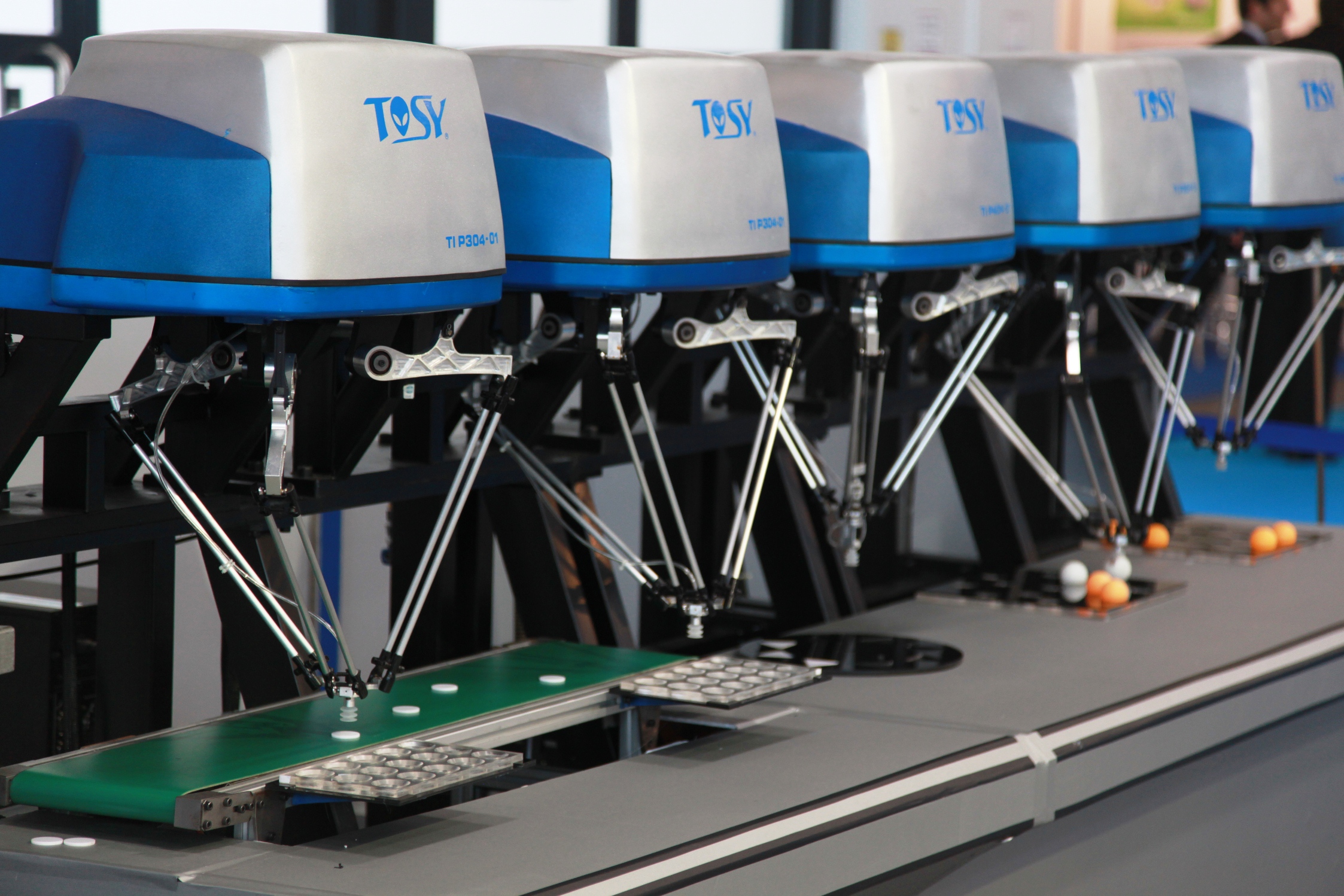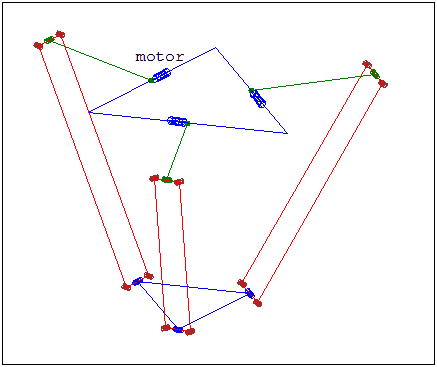Delta robot on:
[Wikipedia]
[Google]
[Amazon]
A delta robot is a type of parallel robot that consists of three arms connected to universal joints at the base. The key design feature is the use of
 The delta robot (a parallel arm robot) was invented in the early 1980s by a research team led by professor Reymond Clavel at the
The delta robot (a parallel arm robot) was invented in the early 1980s by a research team led by professor Reymond Clavel at the
Conception d'un robot parallèle rapide à 4 degrés de liberté
PhD Thesis, EPFL, Lausanne, Switzerland and received the golden robot award in 1999 for his work and development of the delta robot. Also in 1999, ABB Flexible Automation started selling its delta robot, the FlexPicker. By the end of 1999, delta robots were also sold by Sigpack Systems. In 2017, researchers from
 The delta robot is a parallel robot, i.e. it consists of multiple
The delta robot is a parallel robot, i.e. it consists of multiple
 Industries that take advantage of the high speed of delta robots are the food, pharmaceutical and electronics industry. For its stiffness it is also used for surgery, in particular, the Surgiscope is a delta robot used as a microscopic holder system.
The structure of a delta robot can also be used to create haptic controllers. More recently, the technology has been adapted to 3D printers.
Industries that take advantage of the high speed of delta robots are the food, pharmaceutical and electronics industry. For its stiffness it is also used for surgery, in particular, the Surgiscope is a delta robot used as a microscopic holder system.
The structure of a delta robot can also be used to create haptic controllers. More recently, the technology has been adapted to 3D printers.
parallelogram
In Euclidean geometry, a parallelogram is a simple polygon, simple (non-list of self-intersecting polygons, self-intersecting) quadrilateral with two pairs of Parallel (geometry), parallel sides. The opposite or facing sides of a parallelogram a ...
s in the arms, which maintains the orientation of the end effector. In contrast, a Stewart platform
A Stewart platform is a type of parallel manipulator that has six prismatic joint, prismatic actuators, commonly hydraulic jacks or electric linear actuators, attached in pairs to three positions on the platform's baseplate, crossing over to thr ...
can change the orientation of its end effector.Bonev, I. The True Origins of Parallel Robots. Online article available at http://www.parallemic.org/Reviews/Review007.html
Delta robots have popular usage in picking and packaging in factories because they can be quite fast, some executing up to 300 picks per minute.
History
École Polytechnique Fédérale de Lausanne
The École Polytechnique Fédérale de Lausanne (, EPFL) is a public university, public research university in Lausanne, Switzerland, founded in 1969 with the mission to "train talented engineers in Switzerland".
Like its sister institution E ...
(EPFL, Switzerland
Switzerland, officially the Swiss Confederation, is a landlocked country located in west-central Europe. It is bordered by Italy to the south, France to the west, Germany to the north, and Austria and Liechtenstein to the east. Switzerland ...
). After a visit to a chocolate maker
Chocolate is a food made from roasted and ground cocoa beans that can be a liquid, solid, or paste, either by itself or to flavor other foods.
Cocoa beans are the processed seeds of the cacao tree (''Theobroma cacao''); unprocessed, they ta ...
, a team member wanted to develop a robot to place pralines in their packages. The purpose of this new type of robot was to manipulate light and small objects at a very high speed, an industrial need at that time.
In 1987, the Swiss company Demaurex purchased a license for the delta robot and started the production of delta robots for the packaging industry. In 1991, Reymond Clavel presented his doctoral thesis 'Conception d'un robot parallèle rapide à 4 degrés de liberté',Clavel, R. (1991Conception d'un robot parallèle rapide à 4 degrés de liberté
PhD Thesis, EPFL, Lausanne, Switzerland and received the golden robot award in 1999 for his work and development of the delta robot. Also in 1999, ABB Flexible Automation started selling its delta robot, the FlexPicker. By the end of 1999, delta robots were also sold by Sigpack Systems. In 2017, researchers from
Harvard
Harvard University is a private Ivy League research university in Cambridge, Massachusetts, United States. Founded in 1636 and named for its first benefactor, the Puritan clergyman John Harvard, it is the oldest institution of higher lear ...
's Microrobotics Lab miniaturized
Miniaturization ( Br.Eng.: ''miniaturisation'') is the trend to manufacture ever-smaller mechanical, optical, and electronic products and devices. Examples include miniaturization of mobile phones, computers and vehicle engine downsizing. In e ...
it with piezoelectric actuators to 0.43 grams for 15 mm x 15 mm x 20 mm, capable of moving a 1.3 g payload around a 7 cubic millimeter workspace with a 5 micrometers precision, reaching 0.45 m/s speeds with 215 m/s² accelerations and repeating patterns at 75 Hz.
Design
 The delta robot is a parallel robot, i.e. it consists of multiple
The delta robot is a parallel robot, i.e. it consists of multiple kinematic chain
In mechanical engineering, a kinematic chain is an assembly of rigid bodies connected by joints to provide constrained motion that is the mathematical model for a mechanical system. Reuleaux, F., 187''The Kinematics of Machinery,''(trans. an ...
s connecting the base with the end-effector. The robot can also be seen as a spatial generalisation of a four-bar linkage
In the study of Mechanism (engineering), mechanisms, a four-bar linkage, also called a four-bar, is the simplest closed-Kinematic chain, chain movable linkage (mechanical), linkage. It consists of four Rigid body, bodies, called ''bars'' or ''link ...
.
The key concept of the delta robot is the use of parallelograms which restrict the movement of the end platform to pure translation, i.e. only movement in the X, Y or Z direction with no rotation.
The robot's base is mounted above the workspace and all the actuator
An actuator is a machine element, component of a machine that produces force, torque, or Displacement (geometry), displacement, when an electrical, Pneumatics, pneumatic or Hydraulic fluid, hydraulic input is supplied to it in a system (called an ...
s are located on it. From the base, three middle jointed arms extend. The ends of these arms are connected to a small triangular platform. Actuation of the input links will move the triangular platform along the X, Y or Z direction. Actuation can be done with linear
In mathematics, the term ''linear'' is used in two distinct senses for two different properties:
* linearity of a '' function'' (or '' mapping'');
* linearity of a '' polynomial''.
An example of a linear function is the function defined by f(x) ...
or rotational actuators, with or without reductions (direct drive
A direct-drive mechanism is a mechanism design where the force or torque from a prime mover is transmitted directly to the effector device (such as the drive wheels of a vehicle) without involving any intermediate couplings such as a gear train ...
).
Since the actuators are all located in the base, the arms can be made of a light composite material
A composite or composite material (also composition material) is a material which is produced from two or more constituent materials. These constituent materials have notably dissimilar chemical or physical properties and are merged to create a ...
. As a result of this, the moving parts of the delta robot have a small inertia
Inertia is the natural tendency of objects in motion to stay in motion and objects at rest to stay at rest, unless a force causes the velocity to change. It is one of the fundamental principles in classical physics, and described by Isaac Newto ...
. This allows for very high speed and high acceleration
In mechanics, acceleration is the Rate (mathematics), rate of change of the velocity of an object with respect to time. Acceleration is one of several components of kinematics, the study of motion. Accelerations are Euclidean vector, vector ...
s. Having all the arms connected together to the end-effector increases the robot stiffness, but reduces its working volume.
The version developed by Reymond Clavel has four degrees of freedom
In many scientific fields, the degrees of freedom of a system is the number of parameters of the system that may vary independently. For example, a point in the plane has two degrees of freedom for translation: its two coordinates; a non-infinite ...
: three translations and one rotation. In this case a fourth leg extends from the base to the middle of the triangular platform giving to the end effector a fourth, rotational degree of freedom around the vertical axis.
Currently other versions of the delta robot have been developed:
* Delta with 6 degrees of freedom: developed by the Fanuc
FANUC ( or ; often styled Fanuc) is a Japanese group of companies that provide automation products and services such as robotics and computer numerical control wireless systems. These companies are principally of Japan, Fanuc America Corpora ...
company, in this robot a serial kinematic with 3 rotational degrees of freedom is placed on the end effector
* Delta with 4 degrees of freedom: developed by the Adept
An adept is an individual identified as having attained a specific level of knowledge, skill, or aptitude in doctrines relevant to a particular occult discipline, such as alchemy or magic.
According to magical tradition, adepts stand out from ...
company, this robot has 4 parallelogram directly connected to the end-platform instead of having a fourth leg coming in the middle of the end-effector
* Pocketdelta: developed by the Swiss company Asyril SA, a 3-axis version of the delta robot adapted for flexible part feeding systems and other high-speed, high-precision applications.
* Delta direct drive: a 3 degrees of freedom delta robot having the motor directly connected to the arms. Accelerations can be very high, from 30 up to 100 g.
* Delta cube: developed by the EPFL university laboratory LSRO, a delta robot built in a monolithic design, having flexure-hinges joints. This robot is adapted for ultra-high-precision applications.
* Several "linear delta" arrangements have been developed where the motors drive linear actuators rather than rotating an arm. Such linear delta arrangements can have much larger working volumes than rotational delta arrangements.
The majority of delta robots use rotary actuators. Vertical linear actuators have recently been used (using a linear delta design) to produce a novel design of 3D printer
3D printing, or additive manufacturing, is the construction of a three-dimensional object from a CAD model or a digital 3D model. It can be done in a variety of processes in which material is deposited, joined or solidified under computer ...
. These offer advantages over conventional leadscrew-based 3D printers of quicker access to a larger build volume for a comparable investment in hardware.
Applications
 Industries that take advantage of the high speed of delta robots are the food, pharmaceutical and electronics industry. For its stiffness it is also used for surgery, in particular, the Surgiscope is a delta robot used as a microscopic holder system.
The structure of a delta robot can also be used to create haptic controllers. More recently, the technology has been adapted to 3D printers.
Industries that take advantage of the high speed of delta robots are the food, pharmaceutical and electronics industry. For its stiffness it is also used for surgery, in particular, the Surgiscope is a delta robot used as a microscopic holder system.
The structure of a delta robot can also be used to create haptic controllers. More recently, the technology has been adapted to 3D printers.
References
{{DEFAULTSORT:Delta Robot Robot kinematics Industrial robots Parallel robots